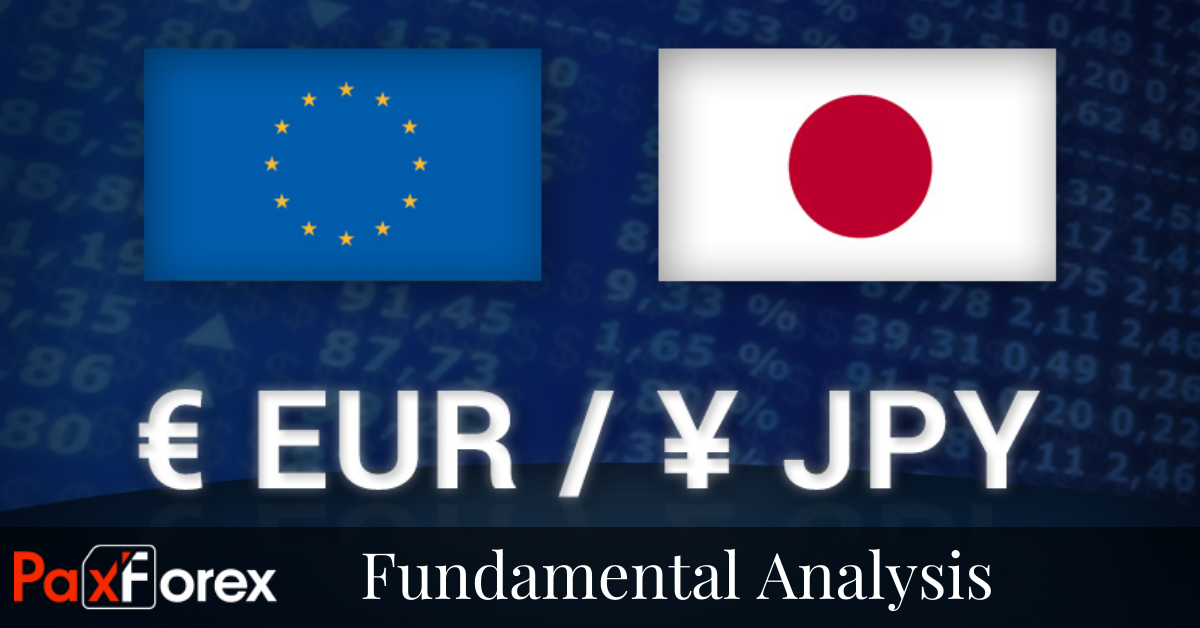
February 21st 2020
The Eurozone Manufacturing PMI rebounded in February but remains below 50.0, indicating the recession is ongoing. German data led the rebound while France contracted below 50.0. Adding worries for the Euro is the slowdown in the German services sector. The EURJPY lost bullish momentum inside of its horizontal resistance area, where will price action move from here? Today’s fundamental analysis will take a look at price action in both directions.
Japanese PMI data plunged as expected, indicating reading below 50.0 across the board. The spread of the coronavirus is showing impacts on the volatile domestic economy. Forex traders opt to ignore economic issues in Japan and favor the safe-haven status of the Japanese Yen. Will bears force a sharp sell-off in the EURJPY, or can bulls pressure this currency pair higher? Subscribe to the PaxForex Daily Fundamental Analysis and earn over 5,000 pips per month.
Here are the key factors to keep in mind today for Euro trades:
- French Manufacturing PMI, Services PMI, and Composite PMI: The Preliminary French Markit Manufacturing PMI for February was reported at 49.7. Economists predicted a figure of 50.7. Forex traders can compare this to the French Markit Manufacturing PMI for January, which was reported at 51.1. The Preliminary French Markit Services PMI for February was reported at 52.6. Economists predicted a figure of 51.3. Forex traders can compare this to the French Markit Services PMI for January, which was reported at 51.0. The Preliminary French Markit Composite PMI for February was reported at 51.9. Economists predicted a figure of 51.0. Forex traders can compare this to the French Markit Composite PMI for January, which was reported at 51.1.
- German Manufacturing PMI, Services PMI, and Composite PMI: The Preliminary German Markit Manufacturing PMI for February was reported at 47.8. Economists predicted a figure of 44.8. Forex traders can compare this to the German Markit Manufacturing PMI for January, which was reported at 45.3. The Preliminary German Markit Services PMI for February was reported at 53.3. Economists predicted a figure of 53.8. Forex traders can compare this to the German Markit Services PMI for January, which was reported at 54.2. The Preliminary German Markit Composite PMI for February was reported at 51.1. Economists predicted a figure of 50.8. Forex traders can compare this to the German Markit Composite PMI for January, which was reported at 51.2.
- Eurozone Manufacturing PMI, Services PMI, and Composite PMI: The Preliminary Eurozone Markit Manufacturing PMI for October was reported at 49.1. Economists predicted a figure of 47.5. Forex traders can compare this to the Eurozone Markit Manufacturing PMI for September, which was reported at 47.9. The Preliminary Eurozone Markit Services PMI for October was reported at 52.8. Economists predicted a figure of 52.2. Forex traders can compare this to the Eurozone Markit Services PMI for September, which was reported at 52.5. The Preliminary Eurozone Markit Composite PMI for October was reported at 51.6. Economists predicted a figure of 51.0. Forex traders can compare this to the Eurozone Markit Composite PMI for September, which was reported at 51.3.
- Italian Industrial New Orders and Industrial New Sales: Italian Industrial New Orders for December increased by 1.4% monthly and by 6.0% annualized. Forex traders can compare this to Italian Industrial New Orders for November, which decreased by 0.2% monthly and 4.3% annualized. Italian Industrial New Sales for December decreased by 3.0% monthly and by 1.4% annualized. Forex traders can compare this to Italian Industrial New Orders for November, which were reported flat at 0.0% monthly, and which increased by 0.2% annualized.
- Eurozone CPI and Eurozone Core CPI: The Eurozone CPI for January is predicted to decrease by 1.0% monthly and to increase by 1.4% annualized. Forex traders can compare this to the Eurozone CPI for December, which increased by 0.3% monthly and 1.4% annualized. The Eurozone Core CPI for January is predicted to decrease by 1.7% monthly and to increase by 1.1% annualized. Forex traders can compare this to the Eurozone Core CPI for December, which decreased by 1.7% monthly, and which increased by 1.1% annualized.
Here are the key factors to keep in mind today for Japanese Yen trades:
- Japanese National CPI: The Japanese National CPI for January increased by 0.7% annualized. Economists predicted an increase of 0.7% annualized. Forex traders can compare this to the Japanese National CPI for December, which increased by 0.8% annualized. The Japanese National Core CPI for January increased by 0.8% annualized. Economists predicted an increase of 0.8% annualized. Forex traders can compare this to the Japanese National Core CPI for December, which increased by 0.9% annualized. The Japanese National CPI Excluding Fresh Food for January increased by 0.8% annualized. Economists predicted an increase of 0.8% annualized. Forex traders can compare this to the Japanese National CPI Excluding Fresh Food for December, which increased by 0.7% annualized.
- Japanese Nikkei Manufacturing PMI: The Preliminary Japanese Nikkei Manufacturing PMI for February was reported at 47.6. Forex traders can compare this to the Japanese Nikkei Manufacturing PMI January, which was reported at 48.8.
- Japanese Jibun Bank Services PMI and Composite PMI: The Preliminary Japanese Jibun Bank Services PMI for February was reported at 46.7. Forex traders can compare this to the previous Japanese Jibun Bank Services PMI for January, which was reported at 51.0. The Preliminary Japanese Jibun Bank Composite PMI for February was reported at 47.0. Forex traders can compare this to the previous Japanese Jibun Bank Composite PMI for January, which was reported at 50.1.
- Japanese All Industry Activity Index: The Japanese All Industry Activity Index for December was reported flat at 0.0% monthly. Economists predicted an increase of 0.3% monthly. Forex traders can compare this to the Japanese All Industry Activity Index for October, which was increased by 0.9% monthly.
- Japanese Nationwide Department Store Sales: Japanese Nationwide Department Store Sales for January decreased by 3.1% annualized. Forex traders can compare this to the Japanese Nationwide Department Store Sales for December, which decreased by 5.0% annualized.
Should price action for the EURJPY remain inside the or breakdown below the 120.350 to 121.350 zone the following trade set-up is recommended:
- Timeframe: D1
- Recommendation: Short Position
- Entry Level: Short Position @ 120.850
- Take Profit Zone: 118.000 – 118.450
- Stop Loss Level: 121.850
Should price action for the EURJPY breakout above 121.350 the following trade set-up is recommended:
- Timeframe: D1
- Recommendation: Long Position
- Entry Level: Long Position @ 121.850
- Take Profit Zone: 122.650 – 122.850
- Stop Loss Level: 121.350
Open your PaxForex Trading Account now and add this currency pair to your forex portfolio. Did you know that you can earn more pips per trade simply by switching to PaxForex? Sign-up now and boost your profits!
We are one of the fastest growing Forex Brokers in the Market. Trade with PaxForex to get the full Forex Trading experience which is based on...
- The Reliability on all Assets in the Market
- Trusted Worldwide for over a Decade
- Live Multi-Lingual Online Support 24/5














